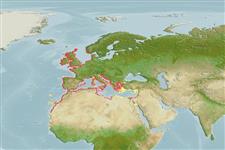Common names from other countries
Environment: milieu / climate zone / depth range / distribution range
экология
; солоноватоводный; пределы глубины 0 - 1 m (Ref. 105875). Tropical, preferred 15°C (Ref. 107945); 61°N - 13°N, 18°W - 36°E
Eastern Atlantic and Mediterranean: from Norway to United Kingdom, France, Spain, Portugal, Morocco, Mauritania, and Senegal, including the Mediterranean, from Spain, France, Monaco, Italy, Slovenia, Croatia, Bosnia and Herzegovina, Montenegro, Albania, Greece, Turkey, Cyprus, Syria, Lebanon, Israel Egypt, Libya, Tunisia, and Algeria. Introduced in Azores Islands. Temperate to tropical.
Length at first maturity / Size / Вес / Возраст
Maturity: Lm ? range ? - ? cm Max length : 8.0 cm SHL самец/пол неопределен; (Ref. 109255); common length : 6.0 cm SHL самец/пол неопределен; (Ref. 437)
Found in sheltered bays, estuaries and lagoons (Ref. 106936). Tends to bury itself in sand, muddy gravel, clay (Ref. 78574) or silty mud (Ref. 107087) and is found on the lower shore and shallow sublittoral (Ref. 78574). Feeds on phytoplankton and detritus (Ref. 107087).
Life cycle and mating behavior
половая зрелость | размножение | нерест | икра | Fecundity | личинки
Members of the class Bivalvia are mostly gonochoric, some are protandric hermaphrodites. Life cycle: Embryos develop into free-swimming trocophore larvae, succeeded by the bivalve veliger, resembling a miniature clam.
Основная ссылка
ссылки | координатор | соавторы
SAUP Database. 2006. (Ref. 356)
Статус Красного Списка МСОП (Ref. 130435)
Статус СИТЕС (Ref. 108899)
Not Evaluated
Not Evaluated
Использование человеком
рыболовство: коммерческий
FAO - аквакультура (рыбоводство): production, Видовой профиль; рыболовство: landings, Видовой профиль | FishSource | Sea Around Us
инструменты
дополнительная информация
ресурсы в Интернет
Estimates based on models
Preferred temperature
(Ref.
115969): 9.4 - 21.1, mean 18.1 (based on 876 cells).
устойчивость к внешним воздействиям
высокий, минимальное время удвоения популяции до 15 месяцев (K=0.44-0.52).
Уязвимость
Low to moderate vulnerability (30 of 100).
